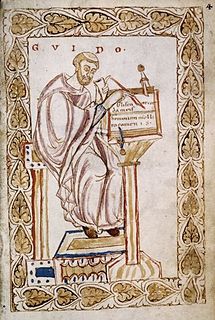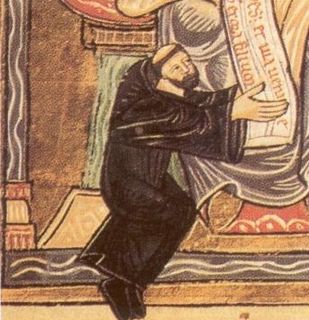Related Research Articles

In the broadest sense, Medieval music encompasses the music of the Western Europe during the Middle Ages, from approximately the 6th to 15th centuries. It is the first and longest era of Western classical music and followed by the Renaissance music; the two eras comprise what musicologists term as early music, proceeding the common practice period. Musicologists generally divide the era into early (500–1150), high (1150–1300), and late (1300–1400) Medieval music.

The Abbey of Saint Gall is a dissolved abbey (747–1805) in a Catholic religious complex in the city of St. Gallen in Switzerland. The Carolingian-era monastery has existed since 719 and became an independent principality between 9th and 13th centuries, and was for many centuries one of the chief Benedictine abbeys in Europe. It was founded by Saint Othmar on the spot where Saint Gall had erected his hermitage. The library of the Abbey is one of the oldest monastic libraries in the world. The city of St. Gallen originated as an adjoining settlement of the abbey. Following the secularization of the abbey around 1800, the former Abbey church became a Cathedral in 1848. Since 1983 the abbey precinct has been a UNESCO World Heritage Site.

Guido of Arezzo was an Italian music theorist and pedagogue of the medieval era. He is regarded as the inventor of modern staff notation that replaced neumatic notation. His text, the Micrologus, was the second most widely distributed treatise on music in the Middle Ages.

Arezzo is a city and comune in Italy and the capital of the province of the same name located in Tuscany. Arezzo is about 80 kilometres southeast of Florence at an elevation of 296 metres (971 ft) above sea level. In 2013 the population was about 99,000.
Odo was the elected king of West Francia from 888 to 898. He was the first king from the Robertian dynasty. Before assuming the kingship, Odo was the count of Paris. He is the first West Francian monarch to reign over a definitively separate kingdom that was part of the Carolingian Empire, never to be reunited again completely.

John Dunstaple was an English composer who was the leading composer of 15th century England and among the most important and influential composers of his time. Crucial in the developing style of the Burgundian School, Dunstaple's music spans the transition from the Medieval to the Renaissance periods.
The Antiphonary tonary missal of St. Benigne was supposed to be written in the last years of the 10th century, when the Abbot William of Volpiano at St. Benignus of Dijon reformed the liturgy of several monasteries in Burgundy. The chant manuscript records mainly Western plainchant of the Roman-Frankish proper mass and part of the chant sung during the matins, but unlike the common form of the Gradual and of the Antiphonary, William organized his manuscript according to the chant genre, and these sections were subdivided into eight parts according to the octoechos. This disposition followed the order of a tonary, but William of Volpiano wrote not only the incipits of the classified chant, he wrote the complete chant text with the music in central French neumes which were still written in campo aperto, and added a second alphabetic notation of his own invention for the melodic structure of the codified chant.

Odo of Cluny was the second abbot of Cluny. He enacted various reforms in the Cluniac system of France and Italy. He is venerated as a saint by the Catholic and Eastern Orthodox Churches. His feast day is 18 November.

Franco of Cologne was a German music theorist and possibly a composer. He was one of the most influential theorists of the late Medieval era, and was the first to propose an idea which was to transform musical notation permanently: that the duration of any note should be determined by its appearance on the page, and not from context alone. The result was Franconian notation.
Johannes Cotto was a music theorist, possibly of English origin, most likely working in southern Germany or Switzerland. He wrote one of the most influential treatises on music of the Middle Ages, De musica, first printed by Gerbert in 1784. The treatise included unusually precise directions for composing chant and organum.
Paolo da Firenze was an Italian composer and music theorist of the late 14th and early 15th centuries, the transition from the musical Medieval era to the Renaissance. More surviving music of the Trecento is attributable to Paolo than to any other composer except for Francesco Landini.

In Medieval music, the Guidonian hand was a mnemonic device used to assist singers in learning to sight-sing. Some form of the device may have been used by Guido of Arezzo, a medieval music theorist who wrote a number of treatises, including one instructing singers in sightreading. The hand occurs in some manuscripts before Guido's time as a tool to find the semitone; it does not have the depicted form until the 12th century. Sigebertus Gemblacensis in c. 1105–1010 did describe Guido using the joints of the hand to aid in teaching his hexachord. The Guidonian hand is closely linked with Guido's new ideas about how to learn music, including the use of hexachords, and the first known Western use of solfège.
Odo is a name typically associated with historical figures from the Middle Ages and before. Odo is etymologically related to the names Otho and Otto, and to the French name Odon and modern version Eudes, and to the Italian names Ottone and Udo; all come from the Germanic word ot meaning "possessor of wealth".

Musica enchiriadis is an anonymous musical treatise of the 9th century. It is the first surviving attempt to set up a system of rules for polyphony in western art music. The treatise was once attributed to Hucbald, but this is no longer accepted. Some historians once attributed it to Odo of Cluny (879-942). It has also been attributed to Abbot Hoger.
Johannes de Grocheio was a Parisian musical theorist of the early fourteenth century. His French name was Jean de Grouchy, but he is best known by his Latinized name. He was the author of the treatise Ars musicae, which describes the functions of sacred and secular music in and around Paris during his lifetime.
Lupus Servatus, also Servatus Lupus, in French Loup, was a Benedictine monk and Abbot of Ferrières Abbey during the Carolingian dynasty, who was also a member of Charles the Bald's court and a noted theological author of the 9th century. He is sometimes regarded as the first humanist of the Early Middle Ages because of the quality of his literary style, his love of learning, and his work as a scribe and textual critic.
A tonary is a liturgical book in the Western Christian Church which lists by incipit various items of Gregorian chant according to the Gregorian mode (tonus) of their melodies within the eight-mode system. Tonaries often include Office antiphons, the mode of which determines the recitation formula for the accompanying text, but a tonary may also or instead list responsories or Mass chants not associated with formulaic recitation. Although some tonaries are stand-alone works, they were frequently used as an appendix to other liturgical books such as antiphonaries, graduals, tropers, and prosers, and are often included in collections of musical treatises.
Odo Ydonc was a 13th-century Premonstratensian prelate. The first recorded appearance of Odo was when he witnessed a charter by Donnchadh, Earl of Carrick, on 21 July 1225. In this document he is already Abbot of Dercongal, incidentally the first Abbot of Dercongal to appear on record.
Guido d'Arezzo is a crater on Mercury. It has a diameter of 58 kilometers. Its name was adopted by the International Astronomical Union (IAU) in 1976. Guido d'Arezzo is named for the Italian music theorist Guido of Arezzo, who lived from 990 to 1050.
References
Clyde Brockett. "Odo 2. Odo of Arezzo", Grove Music Online , ed. L. Macy (accessed May 20, 2006), grovemusic.com (subscription access).
Notes
| | This article about an Italian composer is a stub. You can help Wikipedia by expanding it. |